Creating a balcony garden can be a rewarding and fulfilling experience. It allows you to enjoy the beauty of nature right outside your door and provides an opportunity to grow your food and connect with the environment. You can create a balcony garden that yields year-round harvest by carefully selecting plants that thrive in your climate, designing an efficient layout, and utilizing space-saving techniques. Remember, balcony gardening may require effort and maintenance, but you can ensure success with the right supplies and tools.
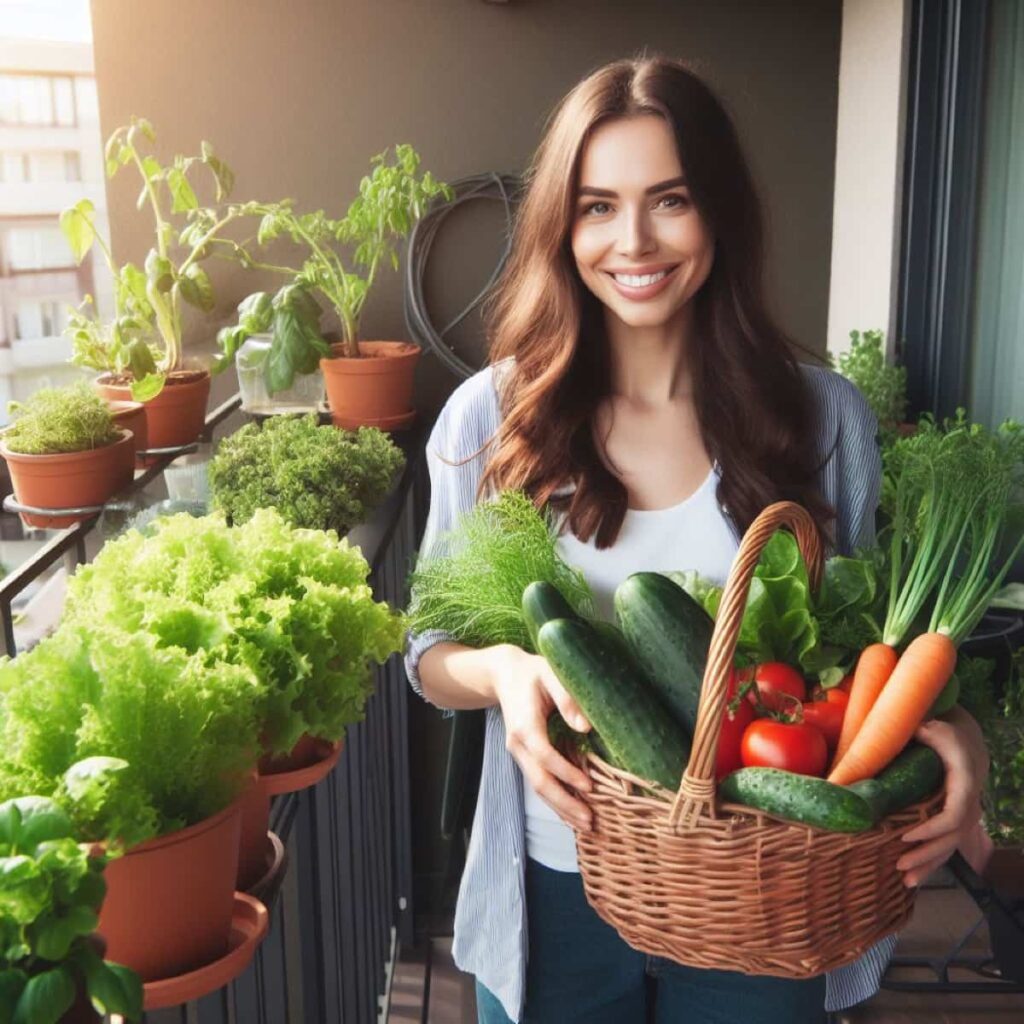
How to Design a Balcony Garden for Year-round Harvests
Understanding the Climate and Microclimate
When designing a balcony garden for year-round harvests, it’s crucial to have a solid understanding of the climate and microclimate in your area. The climate refers to the overall weather patterns you can expect throughout the year, while the microclimate refers to specific conditions within your immediate environment.
To get started, research your region’s average temperatures, rainfall patterns, and length of growing seasons. This information will help you determine which types of plants are best suited for your balcony garden. By understanding the macro and micro aspects of your garden’s climate, you’ll be better equipped to choose plant varieties that can withstand these conditions.
Choosing the Right Plants for Year-Round Harvests
When deciding which plants to grow, it’s crucial to consider their specific needs and requirements. Some crops are more cold-tolerant and can withstand frosty temperatures during winter, while others prefer warmer climates.
| Lettuce | Varieties like Butterhead or Romaine are perfect for cool weather. |
| Kale | A hardy leafy green that thrives in colder temperatures. |
| Herbs (such as Parsley or Cilantro | These versatile plants can be grown indoors during winter months. |
| Tomatoes (determinate varieties) | Choose compact varieties that don’t require extensive staking or support. |
| Peppers | Select dwarf varieties suited for container gardening. |
| Strawberries | Certain everbearing cultivars provide fruit throughout the year. |
In case you missed it: 15 Best Hydroponics Planter Outdoor Kits in India for Home Garden, Balconies, Outdoor and Office Spaces
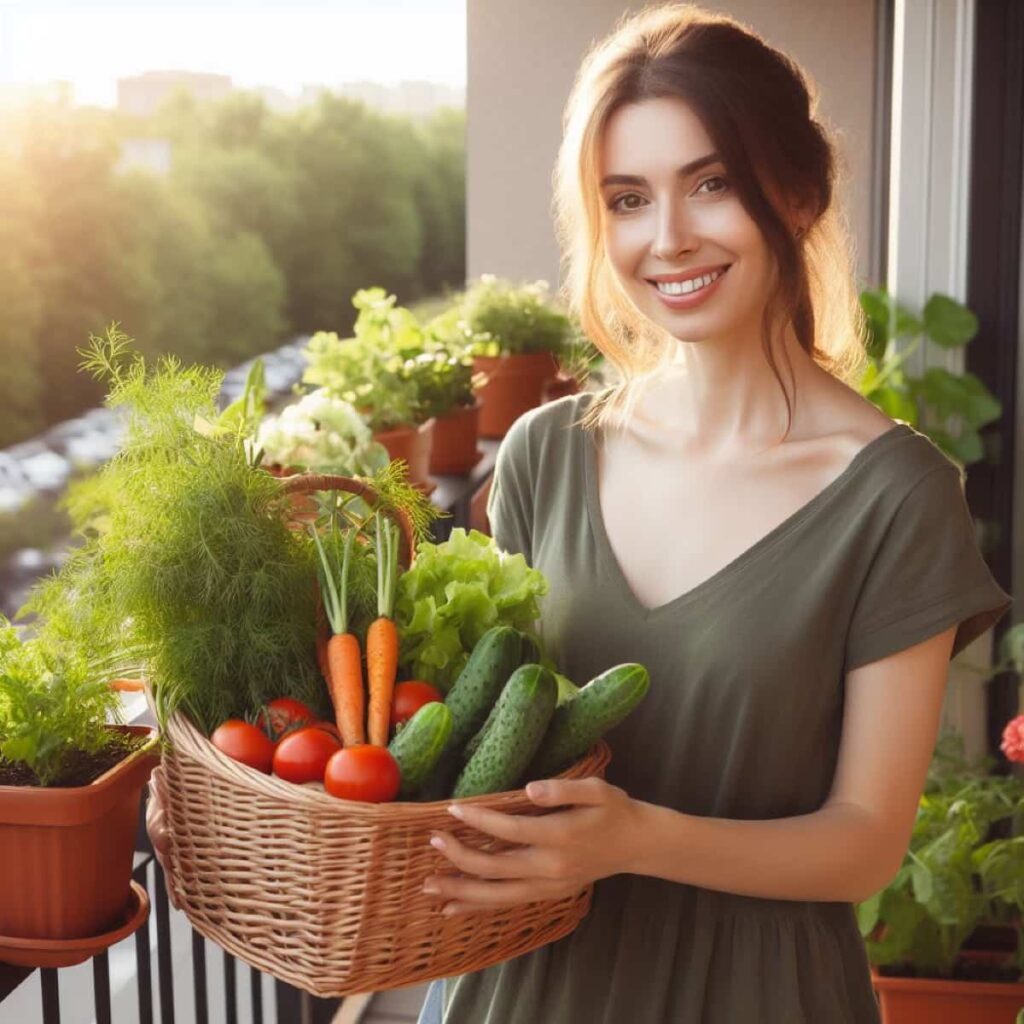
Optimizing Sunlight Exposure
Plants need enough light to thrive and produce bountiful crops. Observe your balcony’s orientation and determine which areas receive the most sunlight throughout the day. This will help you decide where to position your plants strategically. Next, consider using reflective surfaces like mirrors or white walls to bounce light onto shaded areas. This can increase overall sun exposure for your plants.
Another option is utilizing shade cloth or adjustable umbrellas to protect delicate plants from excessive heat during peak sun hours. By filtering some of the intense rays, you create an ideal environment for growth. Furthermore, rotate your containers regularly so that each side of the plant receives equal amounts of sunlight. This simple technique promotes even growth and prevents any side from becoming too leggy.
Creating Adequate Drainage
When designing your balcony garden, it’s essential to consider the drainage needs of your plants. Proper drainage ensures excess water can flow away from the roots, preventing rot and other water-related issues. Select containers or planters with drainage holes at the bottom to create adequate drainage. This allows excess water to escape and prevents waterlogging. If your chosen container doesn’t have pre-drilled holes, you can easily create them using a drill or hammer and nails.
Next, add a layer of coarse gravel or rocks at the bottom of the container. This provides additional space for water to accumulate without saturating the roots. It also helps promote air circulation within the soil. When choosing a potting mix or soil, choose well-draining varieties specifically formulated for container gardening. These mixes usually contain perlite or vermiculite that improves drainage while retaining moisture.
Selecting the Right Containers or Planters
When designing a balcony garden, choosing the right containers or planters is crucial for the success of your year-round harvests. First, consider the material of the containers. Options range from traditional clay pots to modern plastic containers. Each material has advantages and disadvantages, so choose what suits your needs best. Next, consider the size of the containers. Ensure they are large enough to accommodate root growth and provide ample space for plants to thrive.
Remember that larger containers retain moisture better than smaller ones. Additionally, pay attention to drainage holes in your chosen containers. Proper drainage is essential as it prevents waterlogged roots and promotes healthy plant growth. Consider aesthetics when selecting your planters. Choose pots that complement your balcony’s design and enhance its overall beauty.
In case you missed it: How to Grow Gongura from Seeds and Stems in Home Garden: Planting Tips for Terrace, Backyard, and Pots
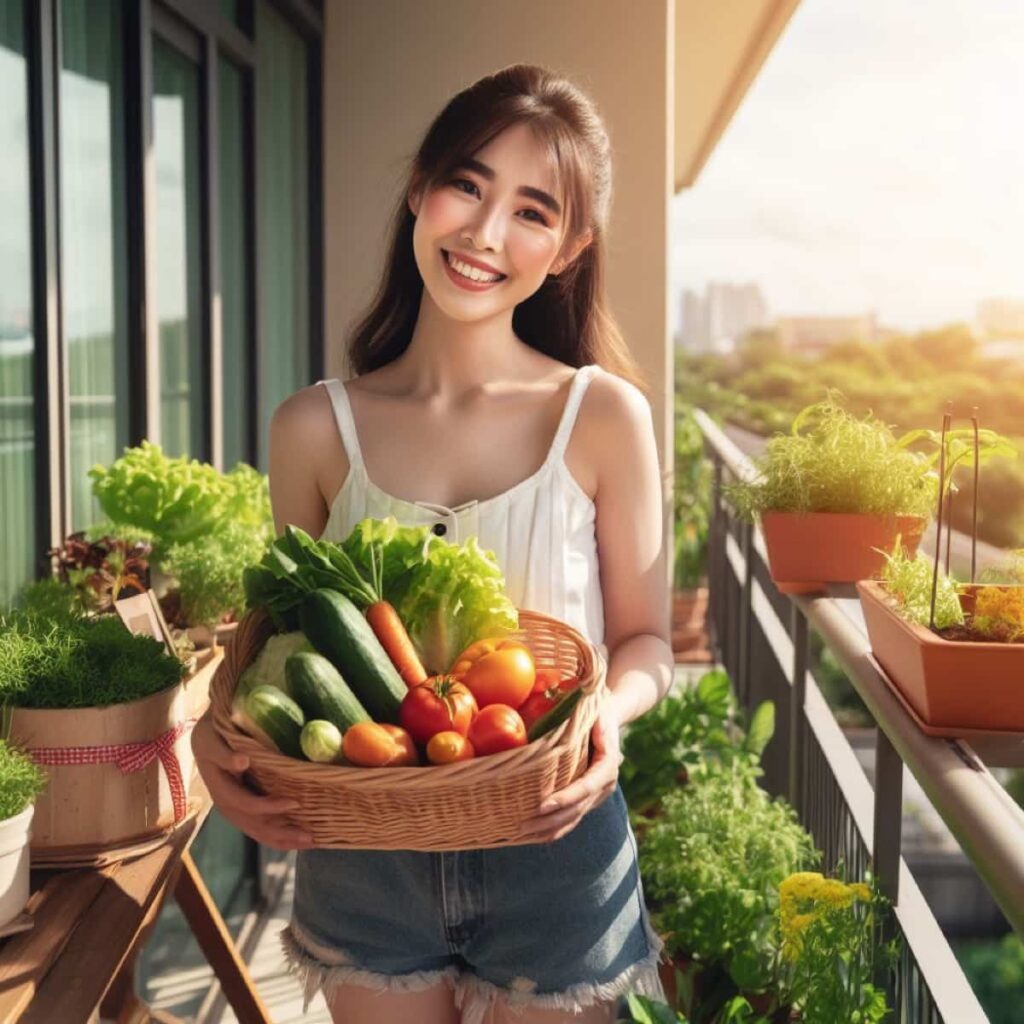
Utilizing Vertical Space
Vertical space is key to maximizing your harvest potential when designing a balcony garden. Consider using trellises, stakes, or hanging baskets to ensure proper growth and support for these vertical plants. These structures provide stability and add visual interest to your balcony garden.
Additionally, incorporating hanging planters or wall-mounted pots can further optimize your use of vertical space. Herbs like Basil or Mint can flourish in these containers while adding fragrance and flavor to your meals. You’ll create a visually appealing display that maximizes productivity by arranging different plants within your balcony garden design at varying heights. Remember to regularly prune and train the vining plants for optimal growth along their designated supports.
Implementing Companion Planting Techniques
One effective way to maximize the productivity of your balcony garden is by implementing companion planting techniques. This method involves strategically planting different types of plants together, harnessing the benefits they provide each other. Companion planting can offer several advantages for your garden. For instance, certain plant combinations can help deter pests, while others can improve soil fertility or attract beneficial insects for pollination. The key is finding plants with compatible growth habits and complementary needs.
A classic example of companion planting is pairing tomatoes with basil. These two plants thrive in similar growing conditions and complement each other’s flavors in culinary dishes. Additionally, basil helps repel pests that commonly affect tomato plants. Another popular combination is marigolds and vegetables like carrots or cabbage. Marigolds emit a scent that repels harmful nematodes, microscopic worms that attack the roots of many vegetable crops.
Incorporating herbs such as rosemary or thyme alongside your fruit-bearing plants can help deter insects and add aromatic scents to your outdoor space. When choosing companion plants, consider their water and sunlight requirements and growth rates to avoid resource competition. Some good combinations include lettuce and radishes since radishes grow quickly and provide shade for lettuce during hot summer.
Providing Proper Nutrient and Soil Management
Nutrient and soil management play a crucial role in the success of your balcony garden. Ensuring your plants access the right nutrients can promote healthy growth and maximize yearly yields.
| Use organic fertilizers | Organic fertilizers provide essential nutrients while improving soil health. Examples include compost, worm castings, and seaweed extract. |
| Test your soil | Conduct regular soil tests to determine its pH level and nutrient content. This will help you adjust fertilizer applications accordingly. |
| Mulch regularly | Apply mulch around your plants to retain moisture, suppress weeds, and improve soil fertility. |
| Rotate crops | Rotating crops helps prevent nutrient depletion by alternating plant families in different growing seasons. |
| Provide balanced nutrition | Ensure your plants receive a balanced mix of macronutrients (nitrogen, phosphorus, potassium) and micronutrients (iron, manganese). |
| Consider foliar feeding | Spraying liquid fertilizer directly onto plant leaves allows for quicker absorption of nutrients. |
In case you missed it: Vegetable Container Size Chart in Inches, Cm, and Gallons: Cost Comparison for Different Container Sizes
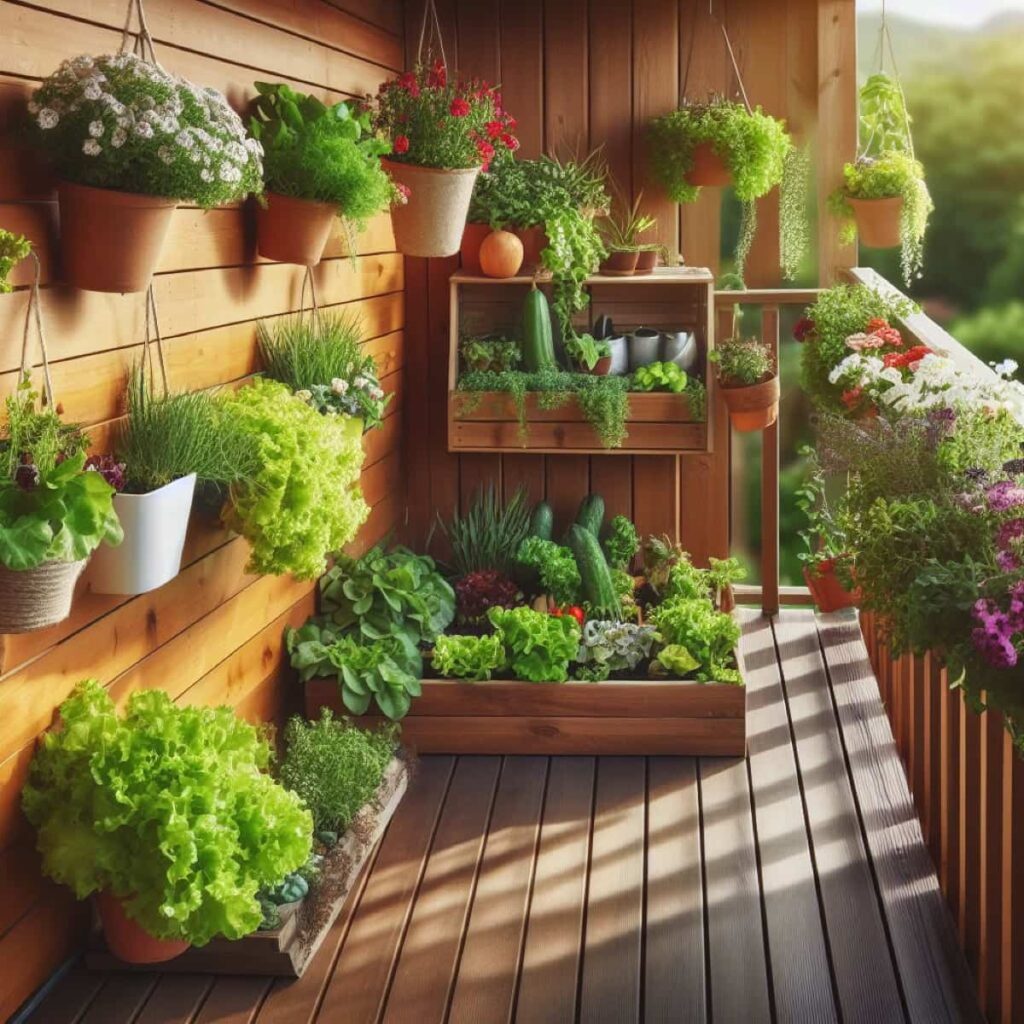
Implementing Watering and Irrigation Systems
Water is essential for the growth and development of plants, especially in a balcony garden where access to natural rainfall may be limited. To ensure your plants receive adequate water, it’s important to implement effective watering and irrigation systems. One option is hand-watering with a watering can or hose attachment that allows for controlled water flow. This method allows you to water each plant based on its specific needs individually. However, it can be time-consuming, especially as your garden grows.
Another option is drip irrigation, which involves placing small hoses or emitters near the base of each plant. Drip irrigation also minimizes weed growth by targeting moisture only where it’s needed. For those who prefer automated systems or have limited time for manual watering, consider installing a timer-controlled sprinkler system or an automated drip irrigation system with adjustable settings. These systems allow you to set specific schedules and durations for watering, ensuring consistency even when you’re away from home.
Protecting Plants from Pests and Diseases
| Companion Planting | By strategically planting certain crops together, you can naturally deter pests. For instance, marigolds repel aphids while attracting beneficial insects like ladybugs. |
| Natural Predators | Encourage the presence of natural predators or beneficial insects. They help control the population of harmful bugs that may infest your plants. |
| Organic Pest Control | Use organic solutions like neem oil or insecticidal soap to combat common pests without harming the environment or beneficial insects. |
| Regular Inspections | Check your plants for symptoms of pest infestation or disease symptoms such as wilting leaves, discoloration, or unusual spots. |
| Crop Rotation | Rotate your crops to prevent the soil-borne diseases that could affect plant health. |
| Proper Hygiene | Practice good hygiene by removing dead foliage promptly and cleaning up fallen debris around your plants, which can harbor pests and diseases. |
Managing Temperature Extremes
| Provide shade | Provide shade to protect your plants from scorching heat during hot summer days. Use umbrellas or install retractable awnings to create a shaded area. |
| Use mulch | Apply a layer of organic mulch to regulate soil temperature and retain moisture. |
| Water wisely | Monitor soil moisture levels closely during extreme temperatures. Water early in the morning or late in the evening when evaporation rates are lower. |
| Install a drip irrigation system | install a drip irrigation system that delivers water to the roots. This helps minimize water loss through evaporation and ensures consistent plant hydration. |
| Use frost protection measures | In colder months, protect sensitive plants from freezing temperatures by using frost cloth blankets or temporarily relocating them indoors. |
| Insulate containers | Wrap insulating materials like bubble wrap around pots during winter to prevent root damage caused by freezing temperatures. |
In case you missed it: Best Indoor Apartment Plants for Small Spaces: Low-Maintenance, Edible, Flowering, Succulents, and Cacti
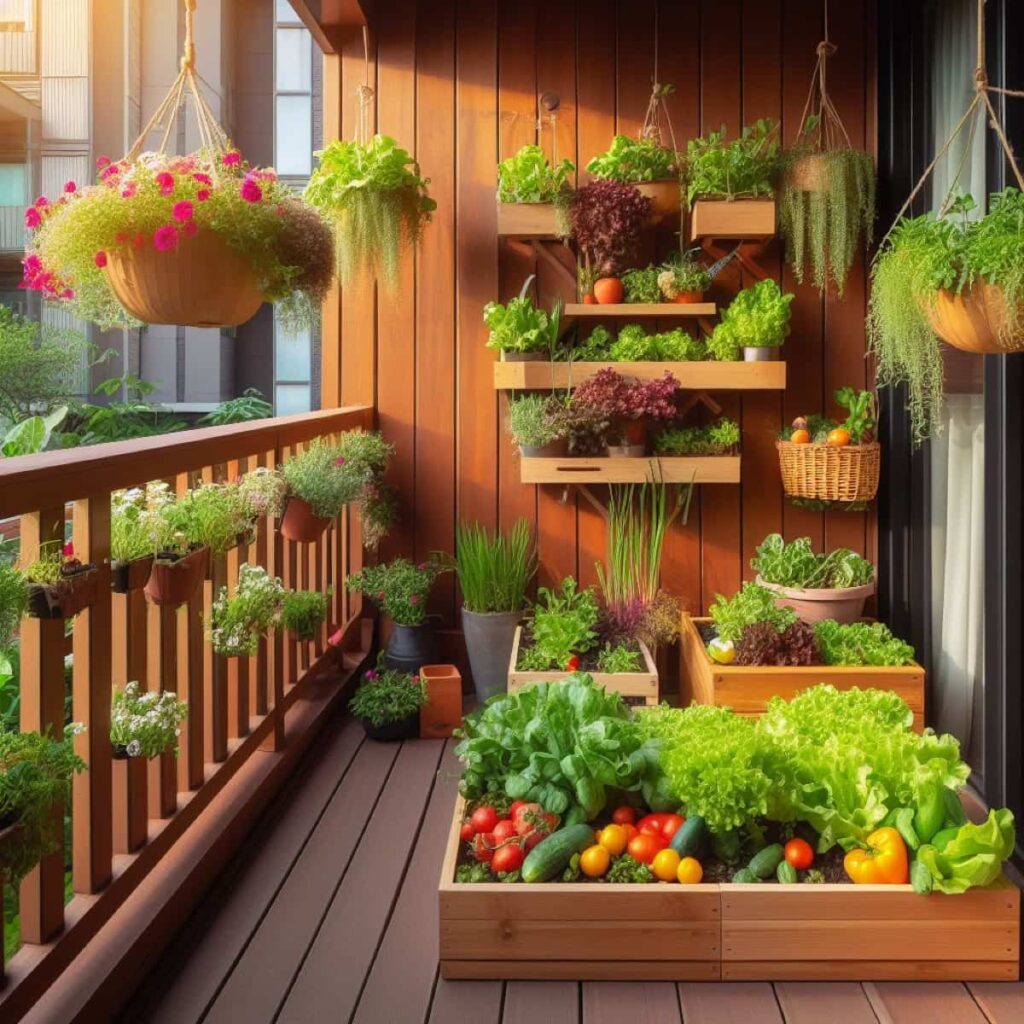
Pruning and Training Plants for Optimal Growth
Pruning and training plants are essential for achieving optimal growth in your balcony garden. Using these techniques, you can shape and direct the growth of your plants to maximize their productivity. Regarding pruning, it’s important to remove any dead or diseased branches regularly. This not only improves the plant’s overall appearance but also prevents the spread of diseases. Additionally, pruning helps promote air circulation within the plant, reducing the risk of fungal infections.
Training plants involves guiding their growth by tying them to supports or trellises. This is particularly useful for vining plants such as tomatoes or cucumbers. By training them vertically, you can save space and ensure better exposure to sunlight for all parts of the plant. Regularly pinching back new growth can also help create bushier and more compact plants. This encourages branching and increases flower production in flowering varieties like herbs or edible flowers.
Harvesting and Preserving Crops
Timing is crucial when harvesting crops. Different plants have different optimal harvest times, so research each crop in your garden for guidance on when to pick them. For example, Lettuce and Spinach should be harvested when they reach full size but before bolting. Once you’ve harvested your crops, handling them with care is important. Use clean tools such as scissors or pruners to cut fruits and vegetables from the plant rather than pulling or twisting them off. After harvesting your crops, consider how you want to preserve them for future use.
You can employ various methods, such as freezing, canning, drying, or even fermenting certain vegetables. Each method preserves flavors and nutrients differently, so choose one that suits the specific crop. For example, herbs like Basil can be dried by hanging them upside down in a warm and dry location until completely dry. Once dried, store them in air-tight containers away from direct sunlight for long-lasting flavor. Preserving crops extends their shelf life and allows you to enjoy homegrown produce during seasons when they might not typically grow outdoors.
Continual Monitoring and Maintenance
Maintaining a successful balcony garden requires ongoing attention and care. Once you’ve designed your space, it’s important to continually monitor and maintain it to ensure optimal growth and harvests throughout the year. Regular monitoring involves observing the health of your plants, checking for signs of pests or diseases, and adjusting watering and nutrient levels as needed. This can be done by taking a few minutes each day to inspect your plants closely.
In addition to visual inspection, keeping track of environmental factors such as temperature fluctuations, sunlight exposure, humidity levels, and rainfall is crucial. This information will help you make informed decisions about supporting your plants’ needs. Regular maintenance tasks include pruning overgrown branches or foliage, removing dead leaves or flowers, and providing additional support for climbing plants. These activities promote healthy growth patterns while preventing overcrowding or potential disease spread.
Frequently Asked Questions About How to Design a Balcony Garden for Year-round Harvests
How Do I Organize My Balcony Garden?
The layout is one of the first things to consider when organizing your balcony garden. Start by assessing how much space you have and what kind of plants you want to grow. If you have limited space, vertical gardening is a great option. Hang pots or use wall-mounted planters to make the most of your area. Next, think about grouping your plants based on their sunlight requirements. Place sun-loving plants together in one area and shade-loving plants in another.
In case you missed it: 20 Best Kitchen Compost Bins With Prices: Low-Cost Composting for Home and Apartment Garden Plants
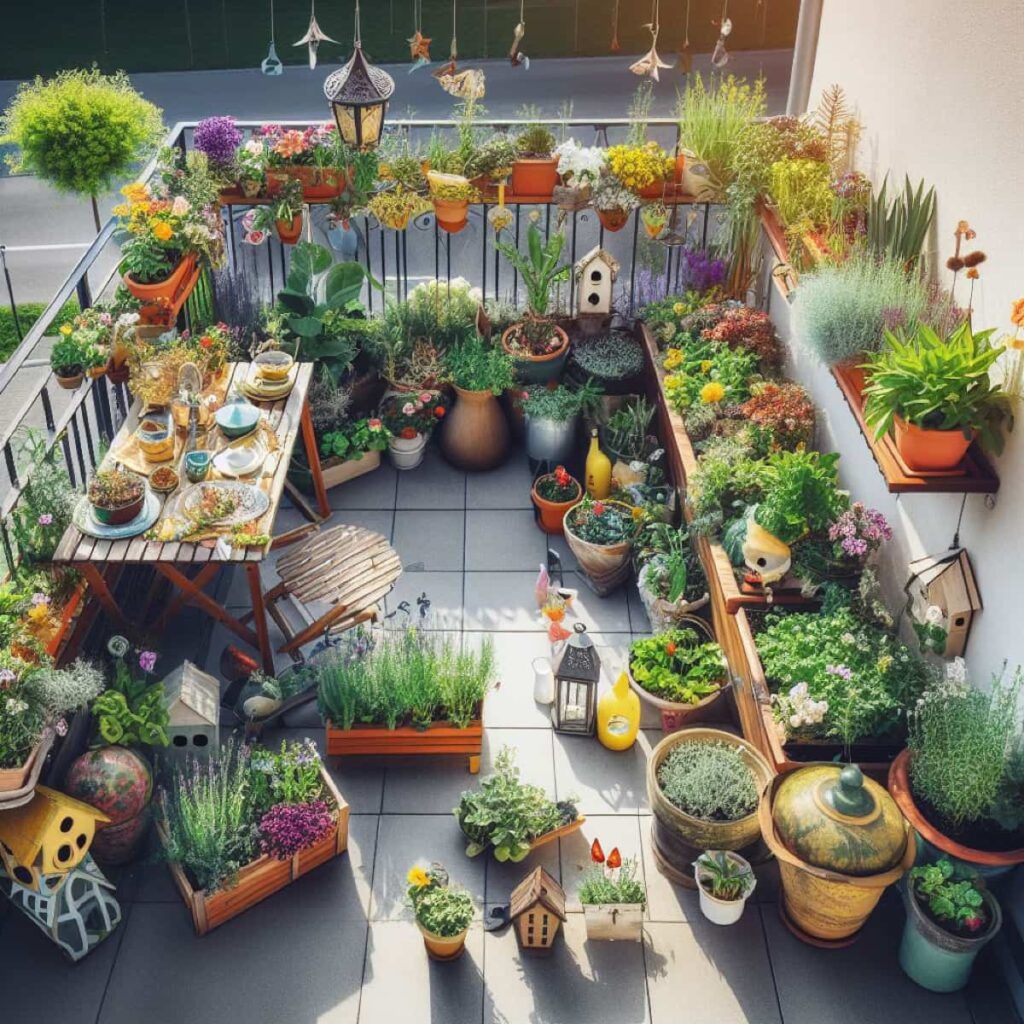
How Do You Style a Balcony with Plants?
When choosing the plants you want to incorporate, consider the size of your balcony. Hanging planters are great for vertical spaces, while potted plants can add beauty to smaller balconies. Mixing different plant heights and sizes adds visual interest. Place taller and shorter plants in front at the back to create depth. You can also experiment using wooden crates, colorful pots, or even repurposed items like old buckets or tin cans.
Conclusion
Designing a balcony garden for year-round harvests is rewarding and achievable with the right planning and techniques. By understanding your climate and microclimate, choosing the appropriate plants, optimizing sunlight exposure, creating proper drainage, selecting suitable containers or planters, utilizing vertical space, implementing companion planting techniques, providing adequate nutrients and soil management, implementing watering systems, protecting plants from pests and diseases, managing temperature extremes, pruning, and training plants for optimal growth, harvesting and preserving crops diligently while continually monitoring and maintaining your garden – you can create a thriving oasis on your balcony.
- Budget Friendly Sheep Shed Ideas: Cheap and Low-Cost Tips
- How Much Do Cattle Farmers Make: Revenue Streams in Cattle Farming
- Management Pests and Diseases in Your Cotton Field
- Sheep Farming Business Plan for Beginners
- Aquaponic Farming at Home: A Step-By-Step Guide
- Profitable Village Farming Business Ideas in 2024
- High-Yield Aquaculture: Fast-Growing Fish for Farming
- Effective Fish Pond Construction Techniques for Beginners
- Irrigation and Water Management in Pineapple Farming
- Blossom to Harvest: Mastering Flowering and Pollination in Papaya Farming
- Pig Fattening Essentials: From Selection to Sale for Beginners
- Raising Wagyu Cattle: A Complete Guide for Premium Beef Production
- Soil Types and Their Water Holding Capacity
- Optimizing Irrigation Schedules for Coconut Groves for Enhanced Yield
- Espresso Your Garden: Coffee Grounds for Healthier Acid-Loving Plants
- The Best Soil Mix for Snake Plants: How to Mix Your Own Snake Plant Soil
- Green Thumb Success: Expert Tips for Cultivating Greenhouse Beans All Year Round
- Bloom All Year Round: The Ultimate Guide to Indoor Hyacinth Care
- Eco-Friendly Gardening: How to Make Liquid Fertilizer from Kitchen Waste
- Ultimate Guide to Grow Anise in Pots: Explore Seed Propagation to Harvesting
- Guide to Raising Chester White Pigs: Discover Breed Facts to Growth Management
- Mastering the Elegance: The Ultimate Guide to Weeping Cherry Tree Care, Planting, and Maintenance
- Ultimate Guide to Planting Garlic in Grow Bags: Growing Strategies for Beginners
- How to Fix Spider Plant Leaf-Related Problems: Natural and Organic Remedies
- 10 Reasons Why Your Tulsi Plant is Shedding Leaves: Home Remedies and Solutions
- Optimizing Growth and Yield: The Advantages of Palm Bunch Ash Fertilizer
- Utilizing Neem Oil Extract as a Natural Pesticide for Hydrangea
- From Soil to Harvest: Various Ways in Which Farmers Can Use AI Tools
- Steps to Encourage and Induce Citrus Flowers: A Comprehensive Guide
- How to Fix Snake Plant Leaf-Related Issues: Natural and Organic Remedies
- Transform Your Garden into a Fragrant Oasis with Raat Ki Rani (Night Blooming Jasmine)
- Discover the Ideal Chicken Breeds for Philippine Farms
- How to Create a Poultry Egg Farm Business Plan for Profits
- Grow Lemon Cucumbers Like a Pro: Insider Techniques for Bountiful Yields
- Ultimate Guide to Caring for Your Pink Princess Philodendron: Tips for Thriving Variegation
- Areca Nut Profit Per Acre: Calculating Yield and Cost of Cultivation
